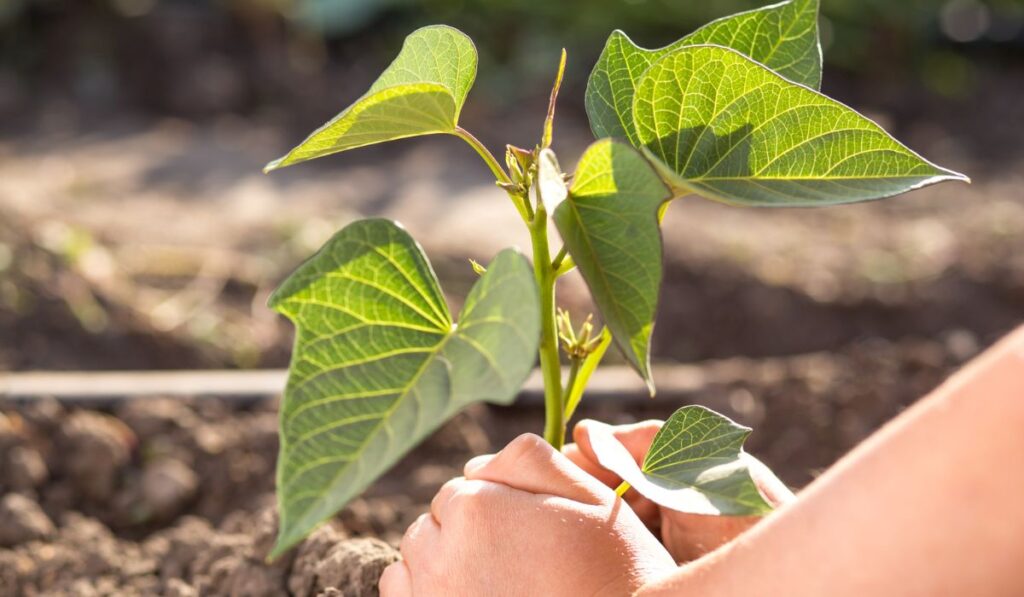Some people may be surprised to learn that sweet potatoes aren’t actually related to regular potatoes — in fact, they belong to the morning glory family. Either way, sweet potatoes are a delicious treat that can be served baked, mashed, whole, or roasted. So, when should you plant your sweet potatoes?
It’s best to plant sweet potatoes in spring, when the ground has thawed and the soil temperature is at least 65 degrees Fahrenheit. Sweet potatoes grow slowly and need warm temperatures to mature into full-size tubers. They prefer 6-8 hours of direct sunlight each day.
Planting sweet potatoes at the right time is very important to enjoy a bumper crop. Let’s look at how you should plant, care for, and harvest this nutritious vegetable. We’ll also look at some sweet potato varieties that are commonly available.
What Are the Different Types of Sweet Potatoes?

Containing plenty of fiber, beta-carotene, and a much lower GI compared to regular white potatoes, sweet potatoes are certainly the healthier choice.
Sweet potato varieties that have orange flesh are the fastest growing, while the other sweet potato varieties available have yellow, white, and even purple flesh.
While cooked orange-flesh varieties are typically moist, the yellow and white types become creamy, and the purple variety is starchy and dry.
Let’s look at the different types of sweet potatoes available:
- Beauregard: Originally grown in Louisiana, the Beauregard sweet potato (on Amazon) also grows well in the north. It takes 90 days to mature and stores well. This type of sweet potato has dark orange flesh and dark red roots.
- Centennial: Also known as ‘Baby Bakers’, this carrot-colored variety is ready to harvest in 100 days.
- Bush Porto Rico: Ideal for small gardens and baking, the Bush Porto Rico is ready in 110 days. Its light, sweet flesh adds nutrients and taste to your table.
- Jewel (aka ‘Yellow Jewel’): Ready for harvest in 120 days, Jewel has light orange skin and isn’t very sweet, which makes it perfect for use in many recipes. It’s packed with a lot of moisture and takes well to baking, boiling, and making into casseroles.
- Georgia Jet: A fast-growing variety, the Georgia Jet is ready in 90 days. Its red skin covers deep orange flesh packed with moisture.
- Stokes: This unique purple-colored sweet potato is full of health benefits. It takes 120 days to mature and is perfect for savory dishes and mashes.
- White Yam: One of the oldest sweet potato varieties available, the White Yam is ready in 100 days. Also called the ‘White Turnip’ due to its color, this sweet potato has dry white flesh.
- Vardaman: This is a bush-type sweet potato that’s perfect for small gardens. Its unique blue/purple foliage, reddish-orange flesh, and golden skin makes it quite unique. It can be harvested after 110 days and has a long storage life.
When to Plant Sweet Potatoes
Sweet potatoes aren’t grown from seeds; instead, you need what are known as ‘slips.’ Slips refer to sprouts that are grown from existing sweet potatoes. You need to plant slips (on Amazon) indoors for almost six weeks before they can be planted outdoors.
Unlike white potatoes, sweet potatoes are extremely frost sensitive. You can’t plant them outside unless you’re absolutely certain that the last frost date has passed.
The ideal time to plant sweet potatoes is when the ground has thawed and the last spring frost date has passed. For places where the ground doesn’t freeze, the best time to plant sweet potatoes is typically a month after the last spring frost date.
Make sure that the soil temperature is at least 65 degrees Fahrenheit before you start planting sweet potatoes.
Most varieties take 90-120 days to mature, so the trick is to plant them early enough. That way, they have time to mature completely, but don’t plant them so early that they might get killed by a late spring frost.
Keep the planting holes at least 12 inches apart and make sure there’s a space of 38 inches between rows. This not only provides the vines with enough space and prevents nutrient or light competition, but it also allows you enough room to move freely through the planting site to water, mulch, and harvest.
How Much Sun Do Sweet Potatoes Need?
Sweet potatoes prefer direct sunlight for 6-8 hours a day. However, in some hot, dry regions they also appreciate a bit of afternoon shade.
What Type of Soil Is Best for Sweet Potatoes?
Sweet potatoes prefer nutrient-rich soil, so prepare a well-drained, sunny planting site with well-aged manure or compost before you start planting.
For soils with water retention issues, using a coco-fiber growing medium (on Amazon) or coir is recommended.
Sandy soil helps sweet potatoes grow better as they need a lot of air space for the roots to reach down easily. So if your soil is rocky, compacted, or clay, then go for raised beds.
Although water-logged soil isn’t healthy for sweet potato plants, dry soil is also quite stressful. Be sure to provide these plants with the required amount of water. Applying a few inches of mulch over the soil also helps to retain moisture and prevents weed growth.
How to Harvest Sweet Potatoes

Harvest-sized sweet potatoes are typically found several inches below the surface of the soil. You can harvest your crop once the leaves start turning yellow, or about 100 days after planting.
Loosen the soil around each sweet potato plant to protect the roots. Pull up the primary crown of the plant and use your hands to dig up the roots.
Be careful when handling sweet potatoes as they bruise easily. Shake off the excess dirt from your harvest but don’t wash the roots.
Be sure to complete harvesting before the first fall frost.
